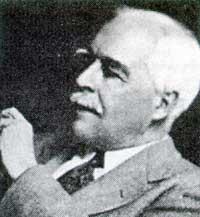Lewis, Gilbert Newton
(1875-1946)

American physicist and chemist founded in 1875 in Weymouhs of Massachusetts, his family emigrated to Lincoln, Nebraska. Their parents had a higher cultural level than the medium and did not agree with the educational system, did not take their children to school until they were old to go to university. The young Gilbert also did so and in 1899 he earned his doctorate at Harvard, after having spent a couple of years as a doctoral student. He became master of thermodynamics and experimental techniques. In 1905 he returned to Massachusetts, where he was appointed assistant researcher at the Technological Institute. After seven years, in 1912 he was appointed Chief and Dean of the Department of Chemistry at Berkeley University of California. He was a professor of thermodynamics and teh Free Energy of Chemical Substances, and thanks to his textbook Thermodynamics and teh Free Energy of Chemical Substances, more than one student managed to overcome the subject. Lewis had a very prosperous life as a researcher. His best-known contribution is the theory of covalence or link theory. Lewis addressed the need for a general explanation of the links between atoms. According to the theory stated by him, the charges are not completely transferred from one atom to another, but an incomplete transfer of a pair of electrons occurs and each electron leaves each atom. Both atoms share the pair of electrons, the nuclei of atoms are held together and one cannot say that the pair is of one atom or another.
In the 1930s the search for the hydrogen isotope began. In 1933 he prepared samples of heavy water and discovered and studied the isotope of hydrogen, deuterium, which had the same properties as hydrogen, but which was twice as heavy as it. He predicted that in the nucleus he had a proton and a neutron, the atomic weight of 2.
In addition to researcher, he was a brilliant professor. As mentioned above, it was intended to make thermodynamics more enjoyable and it can be said that it established a new style of teaching that its students estimated. Knowing that among his students there are many Nobel Prizes can indicate Lewis' ability.
He died in 1946, with a heart attack working in the Berkeley University laboratory.
Buletina
Bidali zure helbide elektronikoa eta jaso asteroko buletina zure sarrera-ontzian











